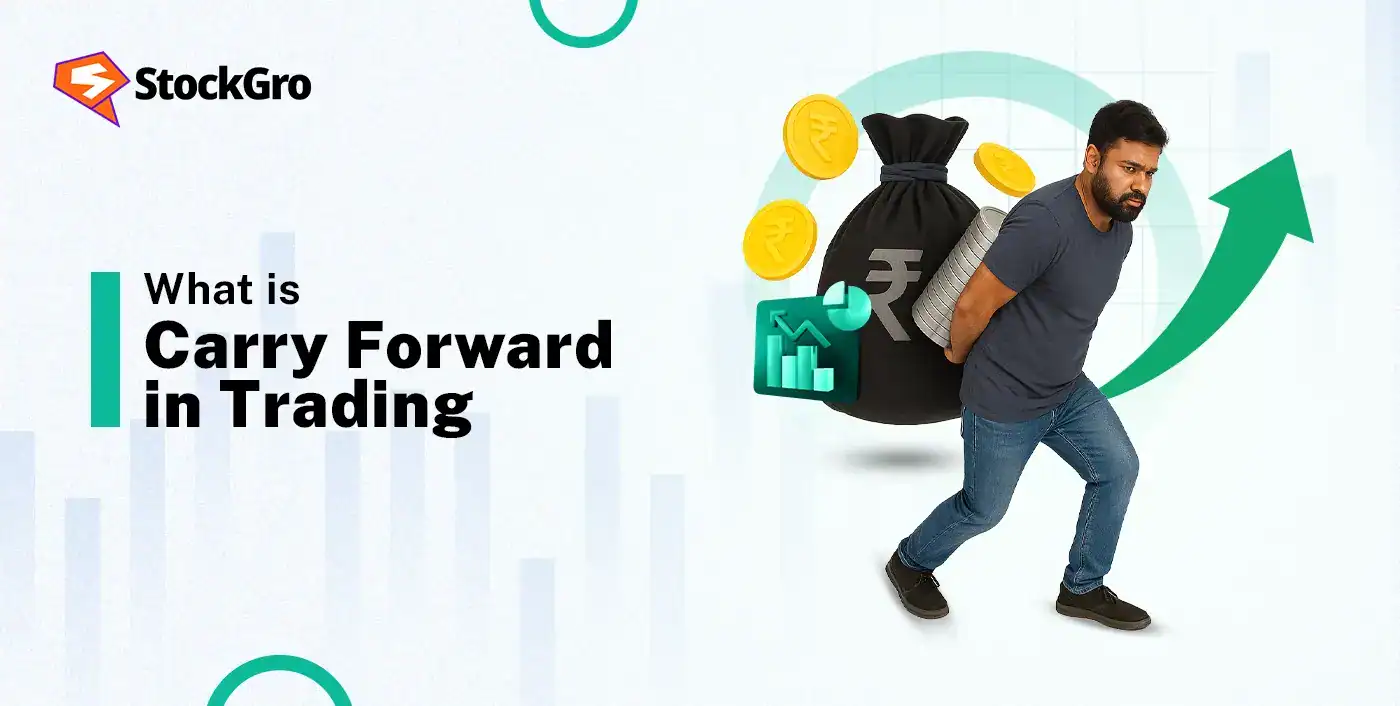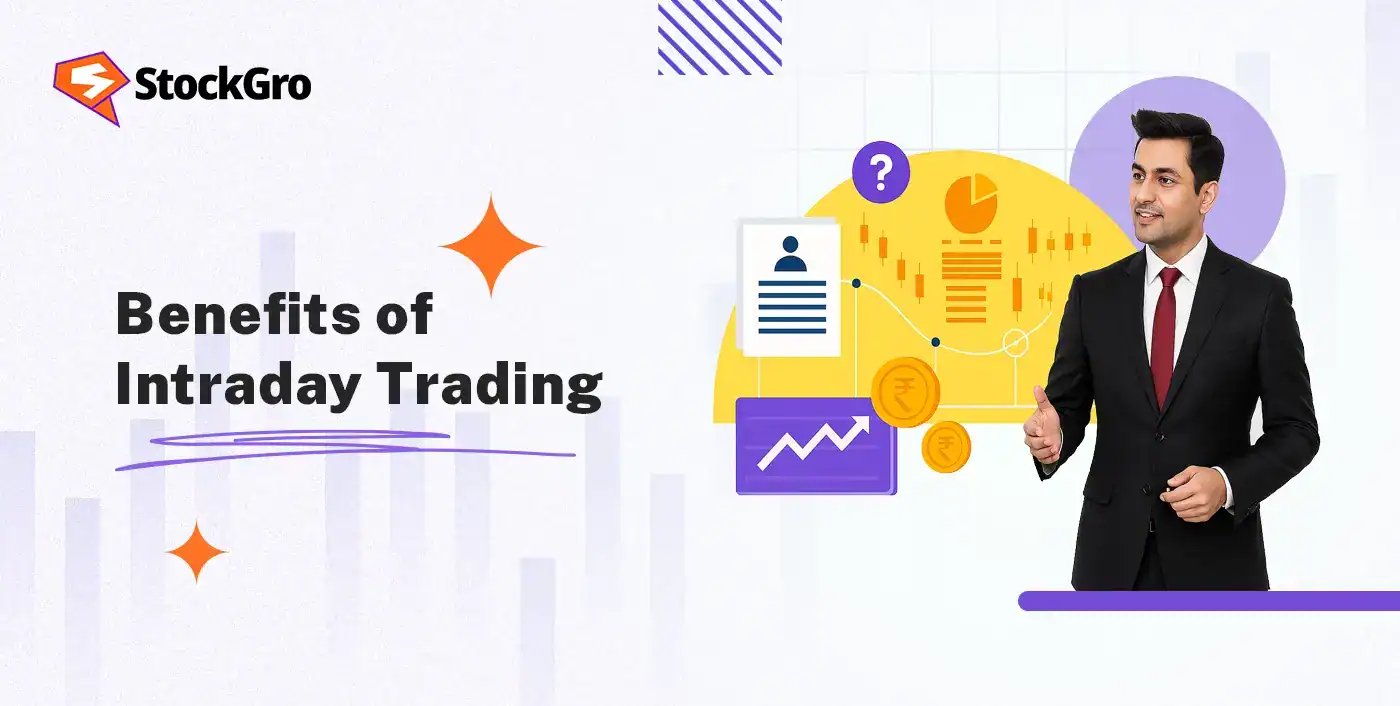
Every trading day tells its own story, as some traders enter and exit within minutes, while others choose to stay in the game a little longer, a phenomenon called carry forward in trading.
Carry forward in trading is basically holding a position for more than a day. It allows traders to benefit from expected price movements over the next few sessions, rather than being limited to intraday movements.
It’s a strategy that offers more flexibility and rewards, but it also subjects the traders to overnight risks and margin requirements.
This blog aims to provide a view of what carry forward is in trading, how it works in the case of delivery and F&O, when a trader should carry forward a position, and much more.
What is Carry Forward Position?
Carrying forward a position means holding an open trade beyond the current trading day instead of closing it before the market ends.
In simple words, if a trader buys or sells a financial security today and does not square it off by the end of the day, they ‘carry forward’ that position to the next trading day. This allows the traders to benefit from potential price movements that may happen overnight or in the coming days.
It is usually used by swing traders and positional traders, who aim to capture larger market trends rather than short-term intraday fluctuations. However, it involves extra costs, margin requirements, and is subject to overnight market risks, which traders must consider before implementing this strategy.
How Carry Forward Works in Stock, F&O & Options
Carry forward in stocks, that is, delivery, refers to holding shares for a long term, while in F&O trading, it means rolling over a contract to a future expiration date.
Carry Forward in Stocks (delivery)
- Trading & Ownership: Carrying forward in stocks or delivery trading means a trader has bought shares and intends to hold them for longer than one day. When a trader buys through delivery, they own the stock and can keep it in the demat account indefinitely.
- Margin Requirement: The trader must have enough margin in their account to hold the shares and carry forward the stock position, or else they may be forced to sell them the next day.
Carry Forward in Futures & Options
- Trading Process: Carrying forward in futures and options (F&O) is the process of closing a current-month contract position and opening a new position in a future-month contract, and it is also called rollover of the current position
- Rollover Strategy: Traders carry forward or rollover futures and options contracts to avoid expiry of a profitable position to a new month, allowing more time for the trade to mature.
3. Differences: Carry Forward vs Intraday vs Delivery
| Elements | Carry Forward | Intraday Trading | Delivery Trading |
| Holding period | In carry forward trading, trade positions are held more than a day | In intraday, the trade positions are squared off within the same trading day | In delivery trading, the shares are held for unlimited time |
| Ownership of shares | There is only a temporary ownership, until the trade is squared off | There is no ownership, and the shares are not credited to the demat account | There is full ownership and the shares are credited to the demat account |
| Margin requirements | It requires margin for overnight holding, which varies by broker | There is leverage, and requires a lower margin | It requires full payment, and no margin facility is available |
| Risks & reward | There is moderate risk, as positions are subject to overnight risks | It involves high risk and fast rewards due to the short-term volatility | It involves lower risk, with potential for capital appreciation |
4. Costs, Margins & Risk Factors in Carry Forward Trades
- Costs in carry-forward trades: Carrying forward positions involves financing costs such as interest on margin, brokerage and stock exchange fees, and for commodities, storage and insurance charges. There’s also an opportunity cost of locked capital and forgone income, like dividends on stock futures.
- Margins in carry-forward trades: The traders must maintain an initial margin to open a position and maintain enough margin to keep it active. If funds fall below the required level, a margin call is issued to add more money.
- Risk factors in carry-forward trades: Carry-forward trades are risky due to leverage and overnight risks. The prices can move sharply, causing heavy losses or margin calls. Also, interest rate changes, mismatched futures and spot prices, or broker liquidations can add up to the risk, especially when positions aren’t monitored.
5. When Should a Trader Carry Forward a Position?
A trader might carry forward a trade position when their analysis indicates continued potential. Let’s see under what circumstances a trader shall carry forward a trade.
- Favourable trend continues: If a position is in profit and has not reached its target by the end of the day, a trader might want to convert it to an overnight or delivery position to capture further gains.
- Futures and options contracts: A trader might rollover a position to maintain engagement with the asset beyond the expiration of the current contract.
- Strategic conversion: A trader might also convert a trade position based on news or market conditions to leverage new opportunities or hedge against risks.
6. Practical Example & Step-by-Step Guide
Let’s understand carry forward in trading with a simple example:
Let’s say, Riya buys 100 shares of Infosys at ₹1,600 each on Monday using a margin trading facility (MTF), by paying 25% upfront, that is ₹40,000, while the rest is financed by her broker. Now, instead of squaring off the position that day, she decides to carry it forward to the next session as she can witness a favourable trend forming.
So, how will she do it? Here’s a step-by-step guide on how to carry forward a trade:
- Open a Position: First of all, Riya placed a buy order for Infosys shares using margin.
- Choose to Carry Forward: Riya selects the carry forward or delivery option in her trading platform before the market closes.
- Pay Interest on Margin: Initially, since the broker funded 75% of the trade, Riya now needs to pay daily interest, that is the cost of carry, on that borrowed amount.
- Monitor Market Movements: The next day, Infosys rises to ₹1,640. Riya now has an unrealised profit of ₹4,000 [(₹1,640 – ₹1,600) x 100 shares].
- Square Off or Continue: Next, she can either sell the shares and book her profit or continue holding if she expects any further upside by paying additional interest for extra days.
7. Tax & Regulatory Implications (India)
Trading activities and taxation as per the trading income classification are regulated by SEBI and the Income Tax Department:
- Intraday Equity Trading: The gains from intraday equity trading are treated as speculative business income. And the profits are added to total income and taxed as per slab rates.
- Futures & Options (F&O) Trading: The gain from F&O trading has been classified as non-speculative business income since 2005, and is taxed at individual slab rates, after deducting business-related expenses like brokerage, internet, or research subscriptions.
- Delivery-Based Equity Trading (Carry Forward Trades): In the case of delivery trading, if it is held for investment purposes, gains are taxed as capital gains:
- Short-Term Capital Gains (STCG): 20%
- Long-Term Capital Gains (LTCG): 12.5% on gains exceeding ₹1.25 lakh.
Bottom line
Carrying forward in trading allows the traders to extend their positions beyond a single day to capture further profitable price moves. While it offers flexibility and potential gains, it also subjects the traders to overnight market risks, margin costs, and interest charges.
Therefore, understanding how it works, its tax treatment, and risk management helps the traders to use this strategy effectively and responsibly.
FAQ‘s
Carrying forward in trading means to hold a position for more than a day, instead of closing it on the same trading day, and it allows the traders to benefit from future price movements.
In intraday trading, all positions are closed within the same day, while in carry-forward trading, trades are held beyond one day, sometimes for multiple sessions.
There is no threshold margin requirement; however, the traders must maintain an initial margin and maintain enough margin. If the account balance falls below the required margin, the brokers will issue a margin call to add more funds.
A trader might carry forward or rollover an F&O position when they expect the price trend to continue beyond the contract’s expiry.
Carry forward trades attract overnight risks like price gaps, interest rate changes, and volatility, which can lead to margin calls or forced selling.
Yes, most brokers allow the traders to convert an intraday trade into a carry-forward position or delivery before market close, depending on the margin availability.
Yes, the delivery trades are taxed as capital gains, while F&O trades are treated as business income as per the Income Tax Act. These are regulated by SEBI and the Income Tax Department.
